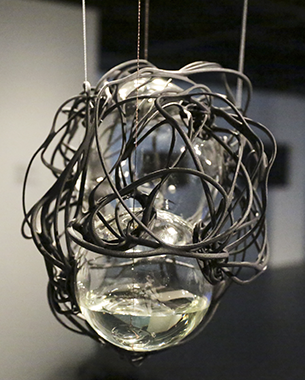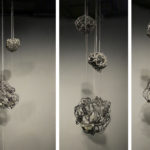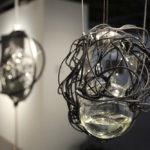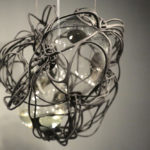Glass blown, 3D printed black polymer (SLS), Calcium Chloride, Water
Common Datum (2020) was made through collaboration between Tobias Klein and Jane Prophet. It is an environmentally reactive, hygroscopic sculpture. A series of suspended vessels continuously absorb the humidity in the exhibition – generated through the breath of the audience. Slowly each 3D printed condenser accumulates water that slowly drips into a series of glass volumes. Even though all vessels are of individual shapes, locally absorbing moisture at a different rate, a common datum is created throughout all of them. The work articulates a confluence between traditional and digital craft in the context of environmental, participatory art.
The air we exhale is 100% saturated with water. The air in the lungs is essentially saturated with water at 37 C, which is about 44 mg/liter. The average lung capacity of an adult is about 6 liters. Once exhaled, the air cools to the ambient temperature, leaving the air supersaturated. If it is cool enough it will form a visible cloud. When our breath comes in contact with a cold surface, it will leave visible condensation.
Common Datum is an environmentally reactive, hygroscopic sculpture. A series of suspended 3D printed vessels continuously absorb the humidity in the meticulously environmentally controlled exhibition space. This humidity stems from the visitors. It is generated through their breath and the conversations they have. The process of filtering this humidity is based on maximizing surface area in lamellae-like 3D printed constructs – condensers -, and through a chemical hygroscopic substance attracting the water from the air. Slowly each 3D printed condenser accumulates water. Upon saturation, it drips along a series of threads drips into three glass volumes, mirroring the murmurs of conversation around the artwork. Without witnesses, in silence, the artworks seize to produce water. It stops, becomes inanimate without visitors, and only restarts when visitors, humidity, can be traced in the vicinity of the artwork.
The work explores the notion of reifying invisible forces, condensing the invisible traces of our presence as a physical element, accumulating the spoken memory of a place – participatory phenomenon -, into a solid form. The work articulates a confluence between traditional and digital craft in the context of environmental art. The articulation of such techne, the condensation, and poiesis, the memory, is a timeless and constant problem of any craftsmanship and one, “…in which Sublimation and Reification act as techne and the methods of Amalgamation/ Augmentation as poiesis.” (Klein, 2018) The medium is the site of an operational synthesis; a confluence of techniques and concepts so symbiotically intertwined that they cannot, and should not, be hierarchised one beneath the other.



